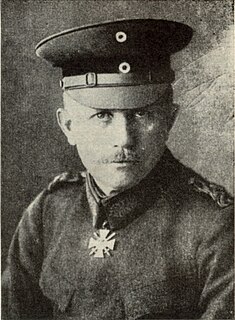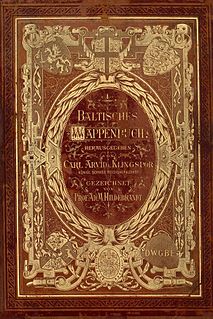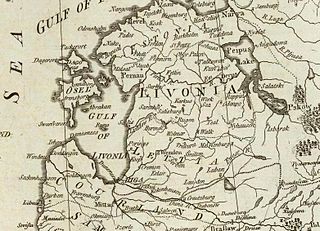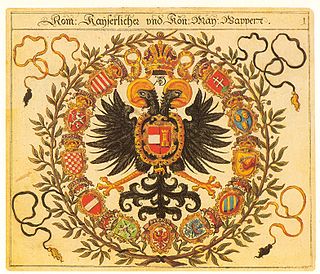
Alexander Friedrich Michael Lebrecht Nikolaus Arthur Graf von Keyserling was a Baltic German geologist and paleontologist from the Keyserlingk family of Baltic German nobility.

Gregor von Helmersen was a Baltic German geologist.

Gustav Adolf Joachim Rüdiger Graf von der Goltz was a German army general during the First World War. He commanded the Baltic Sea Division, which successfully intervened in the Finnish Civil War in the spring of 1918. Goltz stayed with his troops in Finland until December 1918 representing German interests, and in practise ruled the country as a military dictator during this period. After the Armistice of 11 November 1918, Goltz commanded the army of the Baltic German-established Government of Latvia, which in 1919 was instrumental in the defeat of the Russian Bolsheviks and their local allies in Latvia, but suffered a defeat against Estonia and was eventually unsuccessful in retaining German control over the Baltic region after the War.

The Lieven family is one of the oldest aristocratic families of Baltic Germans. Caupo's grandson, Nicholas, was the first to spell his name Lieven.

The Baltic or Baltic German nobility was the privileged social class in the territories of today's Estonia and Latvia. It existed continuously since the Northern Crusades and the medieval foundation of Terra Mariana. Most of the nobility were Baltic Germans, but with the changing political landscape over the centuries, Polish, Swedish and Russian families also became part of the nobility, just as Baltic German families re-settled in e.g. the Swedish and Russian Empires. The nobility of Lithuania is for historical, social and ethnic reasons often separated from the German-dominated nobility of Estonia and Latvia.

The Baltic Landwehr or Baltische Landeswehr was the name of the unified armed forces of Couronian and Livonian nobility from 7 December 1918 to 3 July 1919.

Friedrich Wilhelm Rembert Graf von Berg was a Baltic German nobleman, statesman, diplomat and general who served in the Imperial Russian Army. Berg was a count of the Austrian Empire and Grand Duchy of Finland and the 5th last General-Field Marshal promoted in the history of the Russian Empire. He served as the Governor-General of Finland from 1854 to 1861 and the last Viceroy of the Kingdom of Poland from 1863 to 1874.

Baltic Noble Corporations of Courland, Livonia, Estonia, and Oesel (Ösel) were medieval fiefdoms formed by German nobles in the 13th century under vassalage to the Teutonic Knights and Denmark in modern Latvia and Estonia. The territories continued to have semi-autonomous status from 16th to early 20th century under Swedish and Russian rule.

Siebmachers Wappenbuch is a roll of arms first published in 1605 as two heraldic multivolume book series of armorial bearings or coats of arms of the nobility of the Holy Roman Empire, as well as coats of arms of city-states and some burgher families. Founded and compiled by Johann Ambrosius Siebmacher, a German heraldic artist, copperplate engraver, etcher and publisher from Nuremberg, these works became an important source of heraldry of the German-speaking regions.

With the Capitulation of Estonia and Livonia in 1710 the Swedish dominions Estonia and Livonia were integrated into the Russian Empire following their conquest during the Great Northern War. The Livonian nobility and the city of Riga capitulated on 4 July (O.S.) / 15 July 1710 (N.S.), Pernau (Pärnu) in August, and the Estonian nobility and the city of Reval (Tallinn) on 29 September (O.S.) / 10 October (N.S.). Russia left the local institutions in place and confirmed the traditional privileges of the German nobles and burghers as was established in Privilegium Sigismundi Augusti, especially with respect to the Protestant faith. The land reform of the so-called reduction which had been introduced by the Swedish king Charles XI, and transformed many serfs to subjects of the Crown, was reversed.

Count Karl Wilhelm von Toll was a Baltic German aristocrat and Russian subject who served in the Imperial Russian Army in the campaigns against the Napoleonic Army.
Peeter Järvelaid is an Estonian legal scholar and historian. Järvelaid is a professor in the University of Tallinn. He has developed semiotic and personality-centered research direction, writing hundreds of articles mostly about the European and Estonian legal history and education, published in Estonian, English, German, French, Russian, Latvian, Finnish, Lithuanian and Swedish. Since 2006 his studies have been increasingly concentrated on the international relations in the 20th century, which among others has required intensive archival researches in German and Polish archives. Since 2012 Järvelaid has placed his research emphasis on the German diplomatic missions, with a specific interest in German diplomatic representation in Tallinn.

Oskar Engelhard von Löwis of Menar was a Baltic German ornithologist.
Johann Gotthelf Lindner was a German university teacher and writer at the time of the eighteenth century Enlightenment.
Max Ebert was a German prehistorian known for his studies associated with the Baltic states and South Russia.

Prince Alexander Magnus Friedrich Barclay de Tolly-Weymarn, born as Alexander Magnus Friedrich von Weymarn, was a Baltic German military commander who served in the Imperial Russian Army.
Frydag family is a noble German family, known since the beginning of the 14th century, and who originated from the Uradel of Westphalia and were first documented between 1198 and 1217 with the person of Wecelo Vriedach. At the end of the 13th century, Westphalian aristocrats, among them also members of the Frydags, moved to Prussia and Livonia to fight with and in the Teutonic Order for the spread of Christianity. By marrying in 1574 with the heiress of the Gödens Castle in East Frisia, the Frydag's gained great prestige and wealth. Since 1644 some family lines have been using the title Baron and since 1692 other lines have been using the title Count.

Rennenkampff was a noble Baltic German family. It was of Westphalian origin and originated in Osnabrück. They held the title of Edler.

Kotzebue was a Baltic German noble family of Brandenburgish origin, tracing its origin back to Kossebau in Altmark. They held nobility status in the Russian Empire and the Kingdom of Bavaria.

Toll was a Baltic German noble family of possible Hollandish origin. According to legend, the family's name originated from a castle near Leiden. The family held Swedish and Russian baronial and comital titles, Austrian baronial titles, Prussian, Oldenburgish, Finnish untitled noble status and also possibly belonged to Dutch nobility.
















